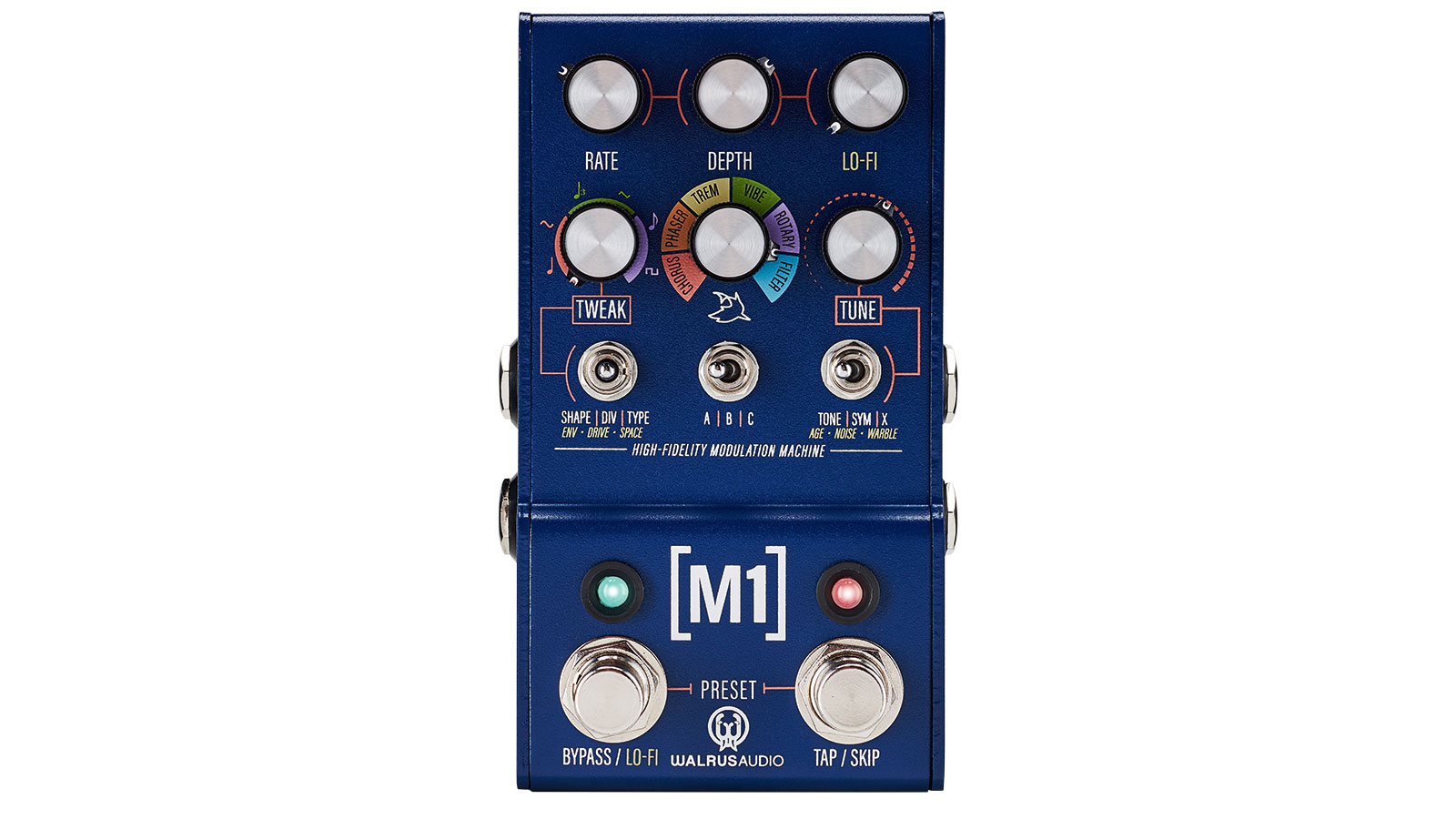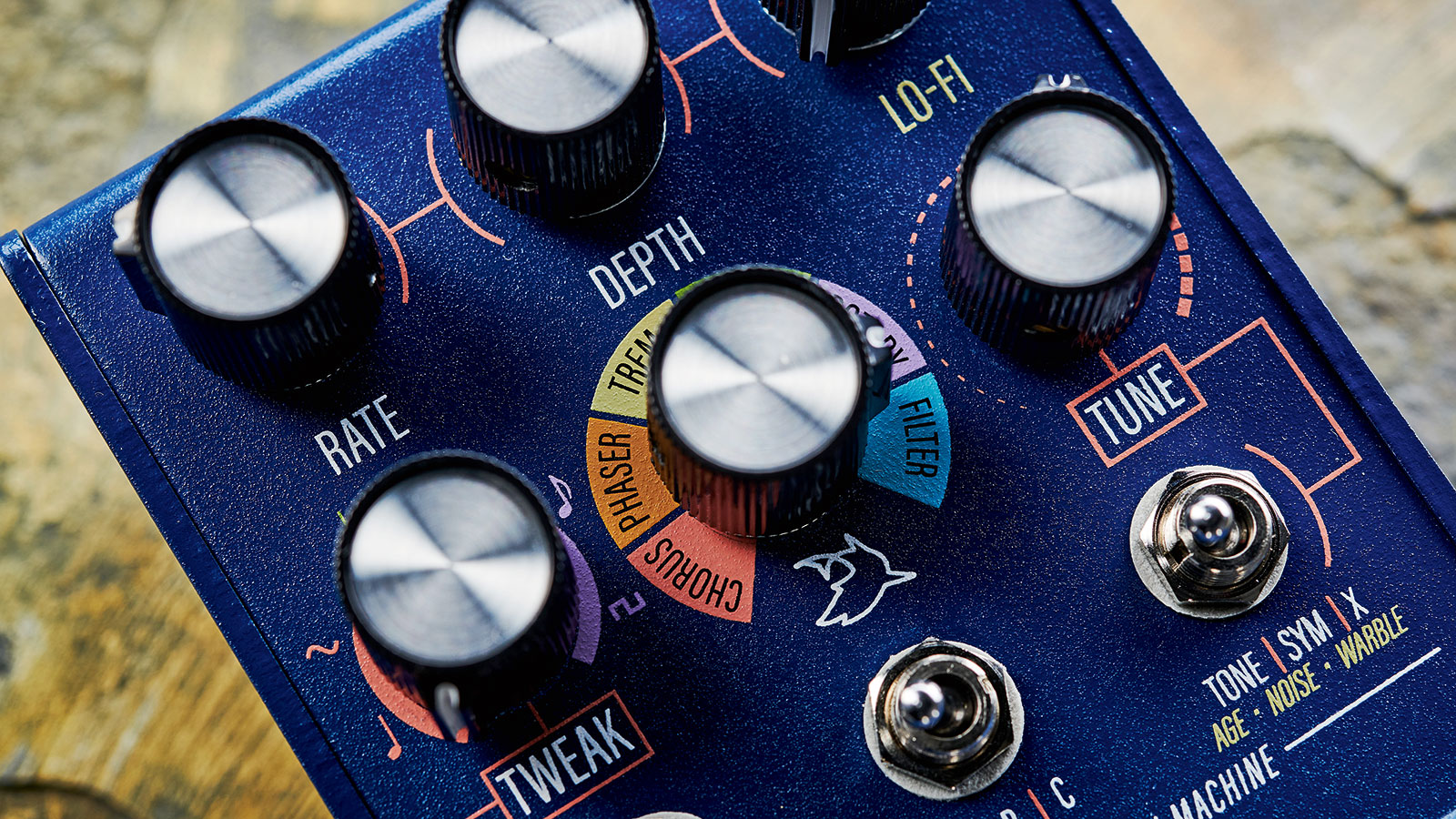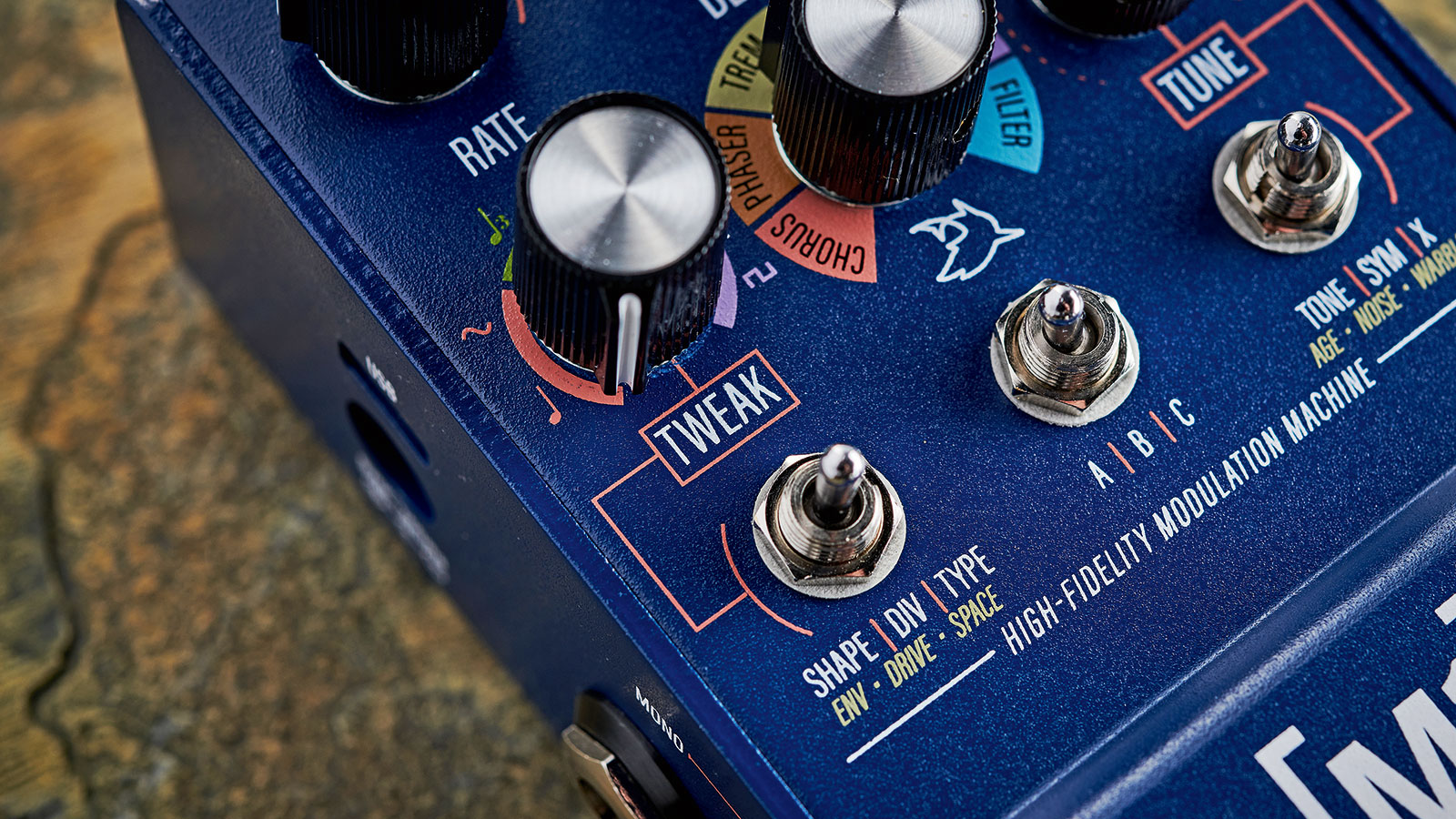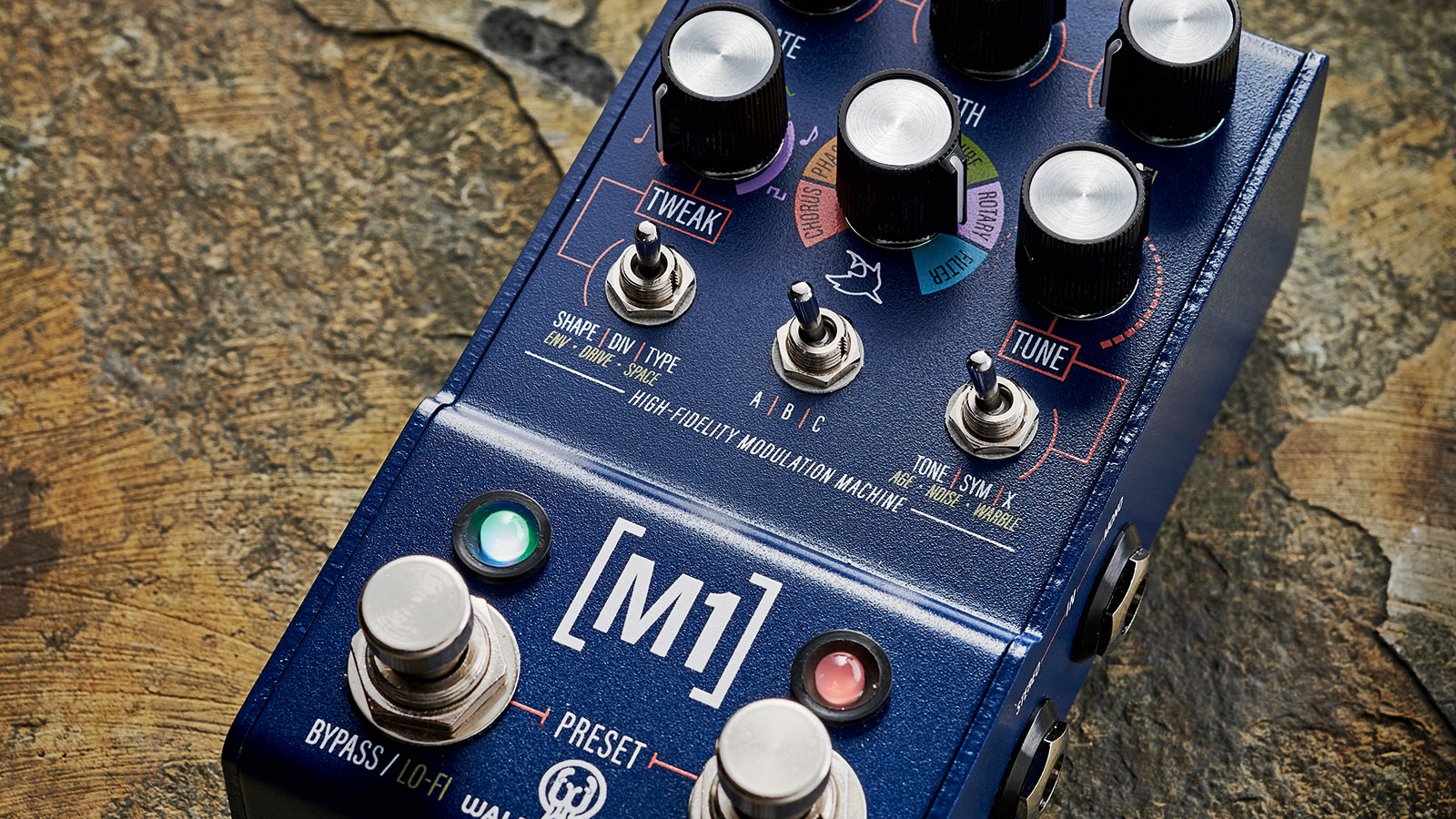Guitar World Verdict
Perhaps not all but most of the modulation effects you’d need, complete with optional lo-fi character, in a classy pedal that won’t hog valuable ’board real estate. Maybe you could use that spare space for the Walrus Polychrome Analog Flanger…
Pros
- +
Compact size.
- +
Useful range of modulation effects.
- +
Plenty of tweak-ability.
- +
Onboard preset storage.
- +
Tap tempo.
Cons
- -
No flanger onboard.
- -
No expression pedal input.
You can trust Guitar World
The M1 is latest in the Mako series and follows the same dual-footswitch, six-knob, three-switch format of its siblings (the R1, D1 and ACS1). What you’re getting is a multi-function modulation pedal with six algorithms that include chorus, phaser, tremolo, vibrato, rotary and filter – but, surprisingly, no flanger.
A massive plus point, however, is the amount of adjustability you get: three different programs (effect types) for each algorithm, plus a further 11 parameters accessible via the front panel, as well as the standard Rate and Depth knobs.
There are also nine onboard preset slots with a full 128 accessible via MIDI, which also allows control over most of the M1’s parameters. There are mono and stereo connectivity options and a tap tempo footswitch, which can also be used for a Skip performance effect.

In Use
The M1’s onboard presets are arranged in three banks and scrolled through by presses on both footswitches simultaneously – the right LED lighting up either red, green or blue to indicate the active preset.
As shipped, the slots are filled with nicely programmed sounds that show off the pedal’s potential and are prime territory as starting points to create your own presets to replace them.
A massive plus point of this multi-function pedal is the amount of adjustability you get
The Tweak and Tune knobs make several adjustments, selected by a three-way switch under each knob. The Tweak knob is divided into three segments so you can choose the program, set an LFO shape (Sine, Triangle Square) and select one of three tap tempo timing divisions.
The Tune knob controls Symmetry for the LFO shape, Tone (EQ) and an X parameter that’s unique to the selected program. Besides these main parameters, a further six Lo-Fi parameters – Envelope, Drive, Space (reverb), Age, Noise and Warble – can be adjusted when the Bypass knob is held down.
Any of the Lo-Fi parameters you dial in are also controlled by the master-mix Lo-Fi knob, which turns them up from zero while maintaining their relative levels.

Sounds
The first chorus program offers a lovely take on traditional chorus pedal that will take you straight back to the 80s. The other two are more complex, representing two choruses in series and that LA studio staple, the Tri-Chorus. Both sound spacey and rich, aided by detuning via the X parameter.
Both two- and four-stage phasers are available, but the third option is a Uni-Vibe emulation that shouldn’t disappoint Jimi fans. There’s one traditional vibrato for those vintage guitar sounds, while the other two programs offer wobble inspired by vintage vinyl and tape – not exactly go-to guitar effects, but it’s refreshing to have access to some different flavors.
The Skip effect is like a needle skipping on a record player, effectively a freeze and repeat function
The first two tremolo programs cover a standard amp-style trem and the phasier harmonic tremolo. There’s plenty of adjustment here purely by choosing sine, triangle or square wave, but the fact you can then adjust the symmetry opens up real, interesting possibilities such as a subtly lopsided sine wave.

The third tremolo option is a pattern trem, basically a sequence effect that encourages use of tap tempo to get its choice of 15 patterns synchronized with your song.
Coupled with parameter control that’s similar to a dedicated rotary pedal, the Rotary options here are either for a full setup or just the horn or drum spinning separately, although both can still be heard.
You can have a Gilmour-style partial rotary effect – the X parameter sets a mix between dry and rotary, and you can instantly toggle between speeds (with appropriate acceleration/deceleration) with the tap tempo footswitch. A press/ hold on it brakes the speaker(s) to a stationary position.
Incidentally, with the other algorithms this action offers a Skip effect, which Walrus describes as being like a needle skipping on a record player. It’s effectively a freeze and repeat function that will repetitively regurgitate the last few milliseconds of audio for you to play over until the switch is released.
The Filter offers a choice of low-pass, hi-pass and bandpass filter types for a useful range of tonal shifts, synthy textures and auto-wah sounds – and it’s here that you can really go to town on the Lo-Fi effects to add in some dirt, or use envelope control to drive the filter frequency with your playing dynamics.
Specs
- PRICE: $349 / £319
- ORIGIN: USA
- TYPE: Modulation pedal
- FEATURES: 3x selectable bypass types (True bypass, DSP+True Bypass (trails), and DSP Bypass), 9x onboard presets, tap tempo, MIDI, 60ms to 2s delay time
- CONTROLS: Program selector, Rate, Depth Lo-Fi, Tweak, Tune, Tweak switch, Bank switch (A/B/C), Tune switch, Tap footswitch, Bypass footswitch
- EFFECTS PROGRAMS: Chorus, Phaser, Trem, Vibe, Rotary, Filter
- CONNECTIONS: Standard inputs (Mono, Stereo), standard outputs (Mono, Stereo), MIDI IN, MIDI THRU, USB
- POWER: 9V DC adaptor (not supplied) 300mA
- DIMENSIONS: 73 (w) x 125 (d) x 60mm (h)
- CONTACT: Walrus Audio
Trevor Curwen has played guitar for several decades – he's also mimed it on the UK's Top of the Pops. Much of his working life, though, has been spent behind the mixing desk, during which time he has built up a solid collection of the guitars, amps and pedals needed to cover just about any studio session. He writes pedal reviews for Guitarist and has contributed to Total Guitar, MusicRadar and Future Music among others.
“The original Jordan Boss Tone was probably used by four out of five garage bands in the late ’60s”: Unpacking the gnarly magic of the Jordan Boss Tone – an actual guitar plug-in that delivers Dan Auerbach-approved fuzz
“This is a powerhouse of a stompbox that manages to keep things simple while offering endless inspiration”: Strymon EC-1 Single Head dTape Echo pedal review













